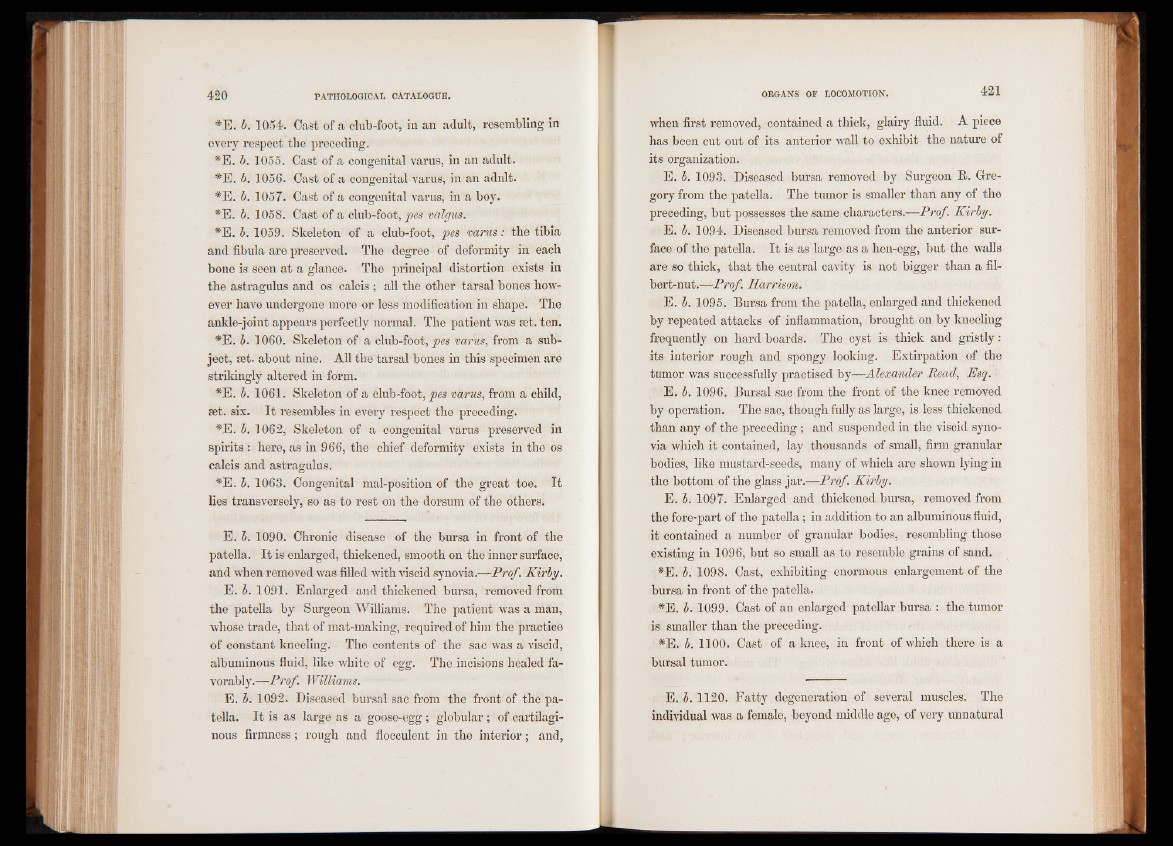
#E. b. 1054. Cast of a club-foot, in an adult, resembling in
every respect the preceding.
*E. b. 1055. Cast of a congenital varus, in an adult.
#E. b. 1056. Cast of a congenital varus, in an adnlt.
#E. b. 1057. Cast of a congenital varus, in a boy.
*E. b. 1058. Cast of a club-foot, pes valgus.
*E. b. 1059. Skeleton of a club-foot, pes varus: the tibia
and fibula are preserved. The degree of deformity in each
bone is seen at a glance. The principal distortion exists in
the astragulus and os calcis ; all the other tarsal bones however
have undergone more or less modification in shape. The
ankle-joint appears perfectly normal. The patient was set. ten.
*E. b. 1060. Skeleton of a club-foot, pes varus, from a subject,
set. about nine. All the tarsal bones in this specimen are
strikingly altered in form.
*E. b. 1061. Skeleton of a club-foot, pes varus, from a child,
set. six. It resembles in every respect the preceding.
*E. b. 1062, Skeleton of a congenital varus preserved in
spirits : here, as in 966, the chief deformity exists in the os
calcis and astragulus.
*E„ b. 1063. Congenital mal-position of the great toe. It
lies transversely, so as to rest on the dorsum of the others.
E. b. 1090. Chronic disease of the bursa in front of the
patella. It is enlarged, thickened, smooth on the inner surface,
and w'hen removed was filled with viscid synovia.—Prof. Kirby.
E. b. 1091. Enlarged and thickened bursa, removed from
the patella by Surgeon Williams. The patient was a man,
whose trade, that of mat-making, required of him the practice
of constant kneeling. The contents of the sac was a viscid,
albuminous fluid, like white of egg. The incisions healed favorably.—
Prof. Williams.
E. b. 1092. Diseased bursal sac from the front of the patella.
It is as large as a goose-egg ; globular; of cartilaginous
firmness; rough and flocculent in the interior; and,
when first removed, contained a thick, glairy fluid. A piece
has been cut out of its anterior wall to exhibit the nature of
its organization.
E. b. 1093. Diseased bursa removed by Surgeon It. Gregory
from the patella. The tumor is smaller than any of the
preceding, but possesses the same characters.—Prof. Kirby.
E. b. 1094. Diseased bursa removed from the anterior surface
of the patella. It is as large as a hen-egg, but the walls
are so thick, that the central cavity is not bigger than a filbert
nut.—Prof. Harrison.
E. b. 1095. Bursa from the patella, enlarged and thickened
by repeated attacks of inflammation, brought on by kneeling
frequently on hard boards. The cyst is thick and gristly :
its interior rough and spongy looking. Extirpation of the
tumor was successfully practised by—Alexander Bead, Esq.
E. b. 1096. Bursal sac from the front of the knee removed
by operation. The sac, though fully as large, is less thickened
than any of the preceding ; and suspended in the viscid synovia
which it contained, lay thousands of small, firm granular
bodies, like mustard-seeds, many of which are shown lying in
the bottom of the glass jar.—Prof. Kirby.
E. b. 1097. Enlarged and thickened bursa, removed from
the fore-part of the patella; in addition to an albuminous fluid,
it contained a number of granular bodies, resembling those
existing in 1096, but so small as to resemble grains of sand.
*E. b. 1098. Oast, exhibiting enormous enlargement of the
bursa in front of the patella.
#E. b. 1099. Cast of an enlarged patellar bursa : the tumor
is smaller than the preceding.
#E. b. 1100. Oast of a knee, in front of which there is a
bursal tumor.
E. b. 1120. Fatty degeneration of several muscles. The
individual was a female, beyond middle age, of very unnatural